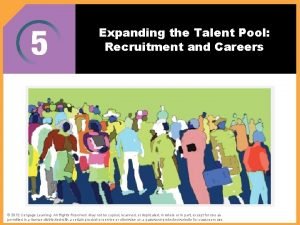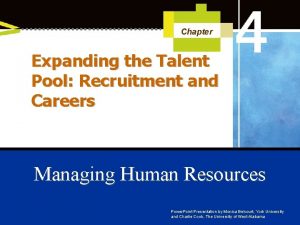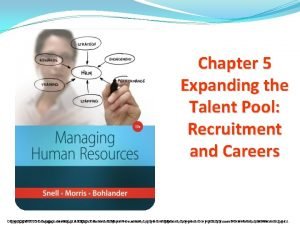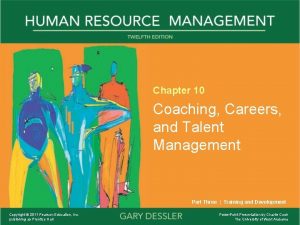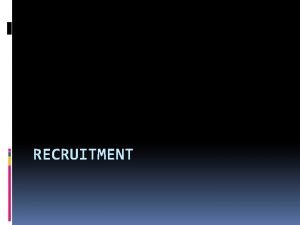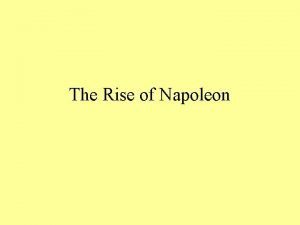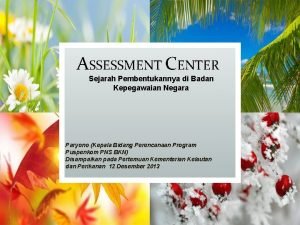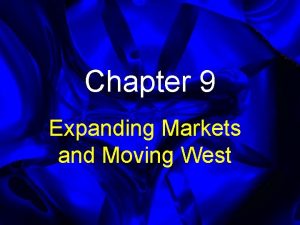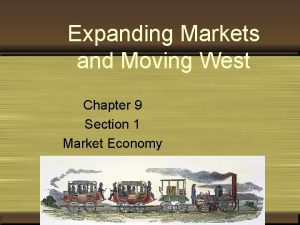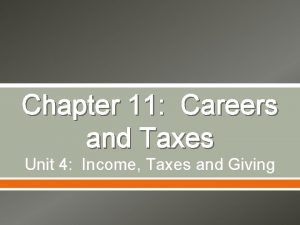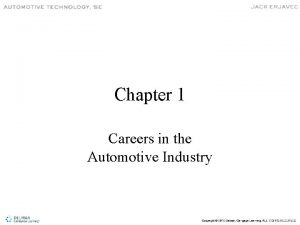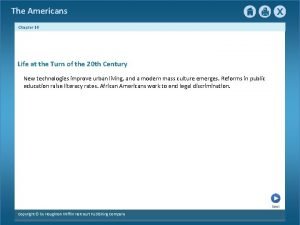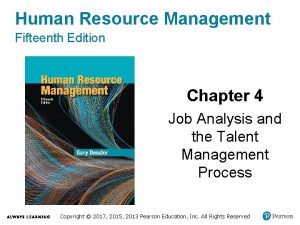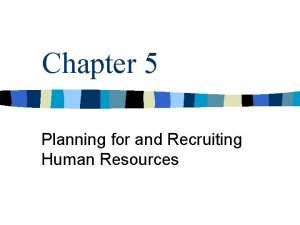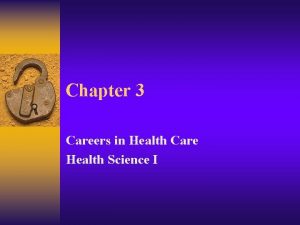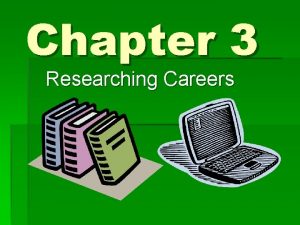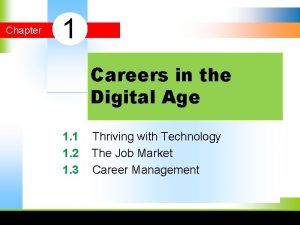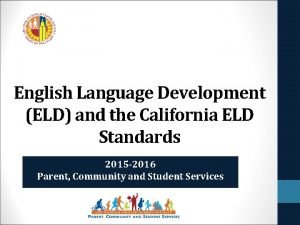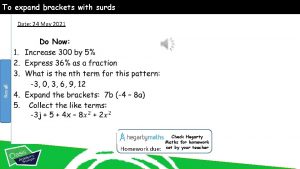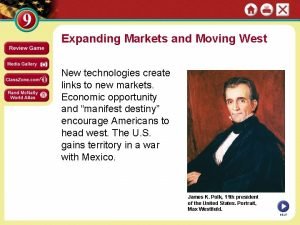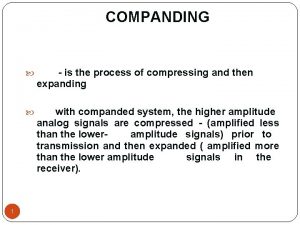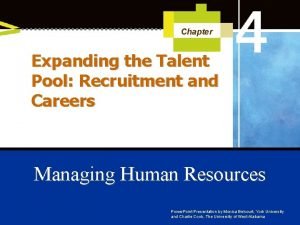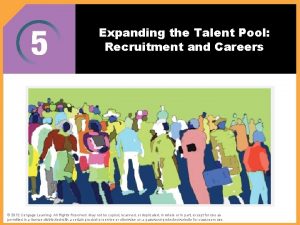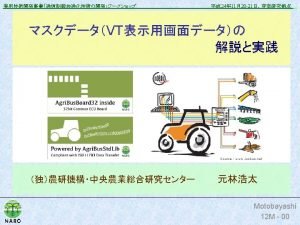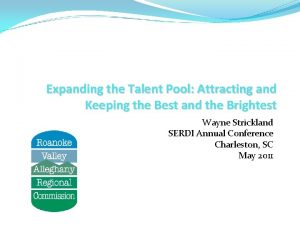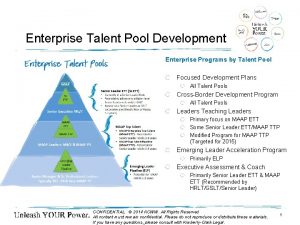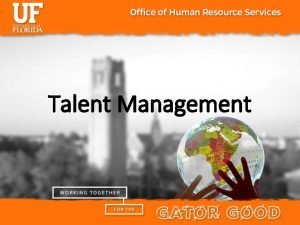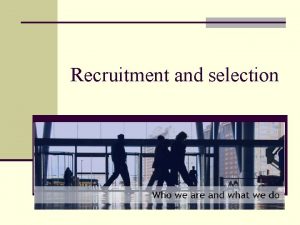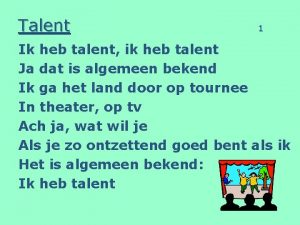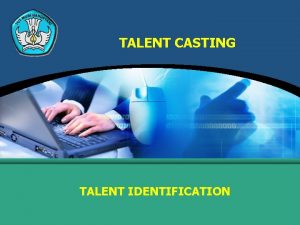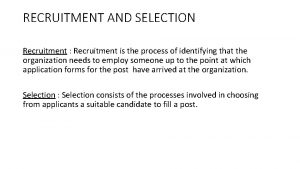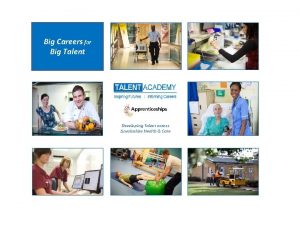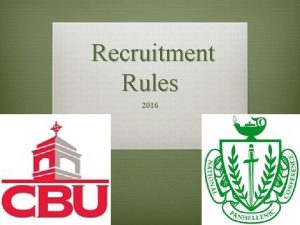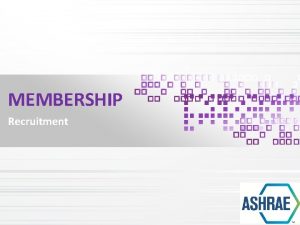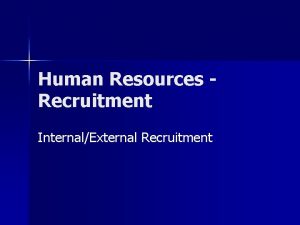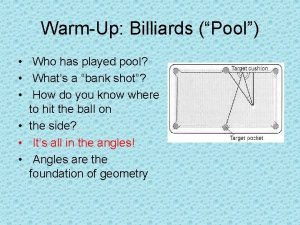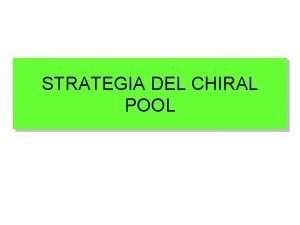Chapter Expanding the Talent Pool Recruitment and Careers






























- Slides: 30

Chapter Expanding the Talent Pool: Recruitment and Careers Managing Human Resources Power. Point Presentation by Monica Belcourt, York University and Charlie Cook, The University of West Alabama

Recruiting Talent Externally • Labor Market – Area from which applicants are to be recruited. • Tight market: high employment, few available workers • Loose market: low employment, many available workers © 2007 Thomson/South-Western. All rights reserved. 5– 2

• Factors determining the relevant labor market: – Skills and knowledge required for a job – Level of compensation offered for a job – Reluctance of job seekers to relocate – Ease of commuting to workplace – Location of job (urban or nonurban) Copyright © 2011 by Nelson Education Ltd. 4– 3

Outside Sources of Recruitment • Advertisements • Labor unions • Unsolicited applications and resumes • Public employment agencies • Internet recruiting • Private employment agencies • Employee referrals • Temporary help agencies • Executive search firms • Employee leasing • Educational institutions • Professional associations © 2007 Thomson/South-Western. All rights reserved. 5– 4

Improving the Effectiveness of External Recruitment Calculate Yield Ratios Training Recruiters External Recruitment Realistic Job Previews © 2007 Thomson/South-Western. All rights reserved. 5– 5

External Recruitment Considerations • Yield Ratio – Percentage of applicants from a recruitment source that make it to the next stage of the selection process. • 100 resumes received, 50 found acceptable = 50% yield. © 2007 Thomson/South-Western. All rights reserved. 5– 6

External Recruitment Considerations • Sources of Organizational Recruiters – Professional HR recruiters – HR generalists – Work team members • Requirements for Effective Recruiters – Knowledge of the recruited job’s requirements and of the organization – Training as an interviewer – Personable and competent to represent the organization © 2007 Thomson/South-Western. All rights reserved. 5– 7

Improving the Effectiveness of External Recruitment (cont’d) • Realistic Job Previews (RJP) – Informing applicants about all aspects of the job, including both its desirable and undesirable facets. – Positive benefits of RJP • • Improved employee job satisfaction Reduced voluntary turnover Enhanced communication through honesty and openness Realistic job expectations © 2007 Thomson/South-Western. All rights reserved. 5– 8

Recruiting Talent Internally • Advantages of a promotion-from-within policy: – Capitalizes on past investments (recruiting, selecting, training, and developing) in current employees. – Rewards past performance and encourages continued commitment to the organization. – Signals to employees that similar efforts by them will lead to promotion. – Fosters advancement of members of protected classes within an organization. © 2007 Thomson/South-Western. All rights reserved. 5– 9

Recruiting Talent Internally (cont’d) • Limitations of a promotion-from-within policy: – Current employees may lack the knowledge, experience or skills needed for placement in the vacant/new position. – The hazards of inbreeding of ideas and attitudes (“employee cloning”) increase when no outsiders are considered for hiring. – The organization has exhausted its supply of viable internal candidates and must seek additional employees in the external job market. © 2007 Thomson/South-Western. All rights reserved. 5– 10

Methods for Identifying Qualified Candidates • Human Resources Information Systems (HRIS) – Database systems containing the records and qualifications of each employee that can be accessed to identify and screen candidates for an internal job opening. • Job Posting and Bidding – Posting vacancy notices and maintaining lists of employees looking for upgraded positions. © 2007 Thomson/South-Western. All rights reserved. 5– 11

Warning Signs of a Weak Talent “Bench” 1. It takes a long time to fill key positions 2. Key positions can be filled only by hiring from the outside. 3. Vacancies in key positions cannot be filled with confidence in the abilities of those chosen for them. 4. Replacements for positions often are unsuccessful in performing their new duties. 5. Promotions are made on the basis of whim, favoritism, or nepotism. Source: Adapted from William Rothwell, Effective Succession (New York: AMACOM, 2000). ©Planning 2007 Thomson/South-Western. reserved. All rights 5– 12

Using Assessment Centers • Assessment Center – A process by which individuals are evaluated as they participate in a series of situations that resemble what they might be called on to handle on the job. • • In-basket exercises Leaderless group discussions Role playing Behavioral interviews © 2007 Thomson/South-Western. All rights reserved. 5– 13

The Goal: Matching Individual and Organizational Needs The Employee’s Role The Organization’s Role Career Management Individual and Organizational Goals © 2007 Thomson/South-Western. All rights reserved. 5– 14

Figure 5– 5 HR’s Role in Career Development © 2007 Thomson/South-Western. All rights reserved. 5– 15

The Organization’s Role: Establishing a Favorable Context • Management Participation – Provide top management support – Provide collaboration between line managers and HR managers – Train management personnel • Setting Goals – Plan human resources strategy • Changing HR Policies – Provide for job rotation – Provide outplacement service • Announcing the Program – Explain its philosophy © 2007 Thomson/South-Western. All rights reserved. 5– 16

Balancing Individual and Organizational Needs © 2007 Thomson/South-Western. All rights reserved. 5– 17

Identifying Career Opportunities and Requirements • Competency Analysis – Measures three basic competencies for each job: know-how, problem solving, and accountability. • Job Progressions – The hierarchy of jobs a new employee might experience, ranging from a starting job to jobs that require more knowledge and/or skill. • Career Paths – Lines of advancement in an occupational field within an organization. © 2007 Thomson/South-Western. All rights reserved. 5– 18

Typical Line of Advancement in HR Management © 2007 Thomson/South-Western. All rights reserved. 5– 19

Recognize Lots of Possibilities • Promotion – A change of assignment to a job at a higher level in the organization. – Principal criteria for determining promotions are merit, seniority, and potential. • Transfer – The placement of an individual in another job for which the duties, responsibilities, status, and remuneration are approximately equal to those of the previous job. © 2007 Thomson/South-Western. All rights reserved. 5– 20

Alternative Career Moves © 2007 Thomson/South-Western. All rights reserved. 5– 21

Stages of Career Development Stage 5: Late Career (ages 55–retirement): Remain productive in work, maintain self-esteem, prepare for effective retirement. Stage 4: Midcareer (ages 40– 55): Reappraise early career and early adulthood goals, reaffirm or modify goals, make choices appropriate to middle adult years, remain productive. Stage 3: Early Career (ages 25– 40): Learn job, learn organizational rules and norms, fit into chosen occupation and organization, increase competence, pursue goals. Stage 2: Organizational Entry (ages 18– 25): Obtain job offer(s) from desired organization(s), select appropriate job based on complete and accurate information. Stage 1: Preparation for Work (ages 0– 25): Develop occupational self-image, assess alternative occupations, develop initial occupational choice, pursue necessary education. © 2007 Thomson/South-Western. All rights reserved. 5– 22

The Plateauing Trap • Career Plateau – Situation in which for either organizational or personal reasons the probability of moving up the career ladder is low. • Types of Plateaus – Structural plateau: end of advancement – Content plateau: lack of challenge – Life plateau: crisis of personal identity © 2007 Thomson/South-Western. All rights reserved. 5– 23

Successful Career-Management Practices Placing clear expectations on employees. Giving employees the opportunity for transfer. Providing a clear and thorough succession plan Encouraging performance through rewards and recognition. Giving employees the time and resources they need to consider short- and long-term career goals. Encouraging employees to continually assess their skills and career direction. © 2007 Thomson/South-Western. All rights reserved. 5– 24

Internal Barriers to Career Advancement Lack of time, budgets, and resources for employees to plan their careers and to undertake training and development. Rigid job specifications, lack of leadership support for career management, and a shortterm focus. Lack of career opportunities and pathways within the organization for employees. © 2007 Thomson/South-Western. All rights reserved. 5– 25

Determining Individual Development Needs • Fast-track Program – A program that encourages young managers with high potential to remain with an organization by enabling them to advance more rapidly than those with less potential. • Career Self-Management Training – Helping employees learn to continuously gather feedback and information about their careers. – Encouraging them to prepare for mobility. © 2007 Thomson/South-Western. All rights reserved. 5– 26

Mentoring • Mentors – Executives who coach, advise, and encourage individuals of lesser rank. • Mentoring functions – Functions concerned with the career advancement and psychological aspects of the person being mentored. • E-mentoring – Brings experienced business professionals together with individuals needing counseling. © 2007 Thomson/South-Western. All rights reserved. 5– 27

Figure 5– 12 Mentoring Functions Source: Matt Starcevich, Ph. D. and Fred Friend, “Effective Mentoring Relationships from the Mentee’s Perspective, ” Workforce, supplement (July 1999): 2– 3. Used with permission of the Center for Coaching and Mentoring, Inc. , http: //coachingandmentoring. com. © 2007 Thomson/South-Western. reserved. All rights 5– 28

Dual-Career Couples • Dual-Career Partnerships – Couples in which both members follow their own careers and actively support each other’s career development. • • • Flexible work schedules Adaptive leave policies Work-at-home On-premises day care Job sharing © 2007 Thomson/South-Western. All rights reserved. 5– 29

High Combinations of Career Interests and Skills Pursue Avoid Develop Low SKILLS Explore Low High INTERESTS © 2007 Thomson/South-Western. All rights reserved. 5– 30
 Recruiting yield pyramid
Recruiting yield pyramid Pool germany
Pool germany Expanding the talent pool recruitment and careers
Expanding the talent pool recruitment and careers Coaching careers and talent management
Coaching careers and talent management Meaning:recruitment
Meaning:recruitment Rise of napoleon
Rise of napoleon The pool talent management
The pool talent management Nsw health talent pool
Nsw health talent pool Civil service talent management
Civil service talent management Simulasi proposal writing
Simulasi proposal writing Chapter 9 expanding markets and moving west
Chapter 9 expanding markets and moving west Chapter 9 expanding markets and moving west
Chapter 9 expanding markets and moving west Chapter 9 expanding markets and moving west
Chapter 9 expanding markets and moving west Section 4 best practices of successful people
Section 4 best practices of successful people Chapter 2 automotive careers and ase certification
Chapter 2 automotive careers and ase certification Chapter 16 section 1 science and urban life
Chapter 16 section 1 science and urban life Human resource management chapter 4
Human resource management chapter 4 Chapter 5 human resource planning and recruitment
Chapter 5 human resource planning and recruitment Chapter 3 careers in health care answers
Chapter 3 careers in health care answers Chapter 3 careers in health care
Chapter 3 careers in health care Chapter 15 preparing for careers
Chapter 15 preparing for careers Chapter 3 researching careers
Chapter 3 researching careers Chapter 1 careers in the digital age
Chapter 1 careers in the digital age Chapter 3 careers in health care
Chapter 3 careers in health care Expanding brackets and solving equations worksheet
Expanding brackets and solving equations worksheet Emerging bridging expanding
Emerging bridging expanding Expanding and simplifying surds
Expanding and simplifying surds Expanding markets and moving west
Expanding markets and moving west Factorising indices
Factorising indices Expanding cubed brackets
Expanding cubed brackets Analog companding
Analog companding
